�
�
�
Contents
Preface
1 The Scene, the Props, the Players
1.1
Introduction and Purpose . . . . . . . . . . . . . . . . . . . .
1.2 A Jaundiced View of Adaptive Control History . . . . . . . .
1.3 Further Perspectives . . . . . . . . . . . . . . . . . . . . . . .
1.3.1 Robustness . . . . . . . . . . . . . . . . . . . . . . . .
1.3.2 Recent Trends
. . . . . . . . . . . . . . . . . . . . . .
1.4 A Gedankenexample . . . . . . . . . . . . . . . . . . . . . . .
1.4.1 Open Loop Identification . . . . . . . . . . . . . . . .
1.4.2 Control Law Selection . . . . . . . . . . . . . . . . . .
1.4.3 Closed Loop Identification . . . . . . . . . . . . . . . .
1.4.4
Summary . . . . . . . . . . . . . . . . . . . . . . . . .
1.5 The Audience . . . . . . . . . . . . . . . . . . . . . . . . . . .
1.6 A Brief Tour
. . . . . . . . . . . . . . . . . . . . . . . . . . .
2 Generalized Predictive Control
2.1
Introduction . . . . . . . . . . . . . . . . . . . . . . . . . . . .
2.1.1 Motivation . . . . . . . . . . . . . . . . . . . . . . . .
2.1.2 What is Predictive Control? . . . . . . . . . . . . . . .
2.1.3 A Brief Historical Perspective . . . . . . . . . . . . . .
2.2 The GPC Method of Clarke et al. . . . . . . . . . . . . . . . .
2.3 Optimal Prediction and GPC Solution . . . . . . . . . . . . .
2.4 A Simple GPC Example . . . . . . . . . . . . . . . . . . . . .
2.5 Closed Loop Formulae . . . . . . . . . . . . . . . . . . . . . .
2.6 GPC Based on a ‘Performance Model’
. . . . . . . . . . . . .
2.7 Conclusions . . . . . . . . . . . . . . . . . . . . . . . . . . . .
v
ix
1
1
3
5
5
6
8
10
13
14
15
16
17
21
21
21
23
24
27
29
32
34
36
42
�
vi
Contents
3 Linear Quadratic Gaussian Optimal Control
3.1
3.2 The Linear Quadratic Regulator
Introduction . . . . . . . . . . . . . . . . . . . . . . . . . . . .
. . . . . . . . . . . . . . . .
3.2.1 The Finite Horizon Regulator . . . . . . . . . . . . . .
3.2.2 The Infinite Horizon Regulator . . . . . . . . . . . . .
3.2.3 The Receding Horizon Regulator . . . . . . . . . . . .
3.3 The Linear Quadratic Tracking Problem . . . . . . . . . . . .
3.4 The Linear Optimal State Estimator . . . . . . . . . . . . . .
3.4.1 The Kalman Predictor (KP)
. . . . . . . . . . . . . .
3.4.2 The Kalman Filter (KF) . . . . . . . . . . . . . . . . .
3.5 Optimal Filter Design with Disturbance Models . . . . . . . .
3.6 LQG Controllers . . . . . . . . . . . . . . . . . . . . . . . . .
3.6.1 The Composite System and the LQ Objective . . . . .
3.6.2 Observers for the Composite System . . . . . . . . . .
. . . . . . . . . . . . . . . . . . . . . . . . . . . . .
3.7 Examples
3.8 Closed Loop Control Formulae
. . . . . . . . . . . . . . . . .
3.9 GPC as LQG . . . . . . . . . . . . . . . . . . . . . . . . . . .
3.9.1 Control Criterion Equivalence . . . . . . . . . . . . . .
3.9.2 An Example
. . . . . . . . . . . . . . . . . . . . . . .
3.10 Conclusions . . . . . . . . . . . . . . . . . . . . . . . . . . . .
43
43
46
46
47
47
48
52
52
53
54
57
57
59
60
70
75
75
77
80
4 Stability and Performance Properties of Receding Horizon
83
83
85
85
89
90
93
94
LQ Control
4.1
Introduction . . . . . . . . . . . . . . . . . . . . . . . . . . . .
4.2 Monotonicity and Stability of Receding Horizon LQ Control .
4.2.1
Stability via the ARE . . . . . . . . . . . . . . . . . .
4.2.2 Monotonicity Properties of the RDE . . . . . . . . . .
4.2.3
Stability via Monotonicity of the RDE . . . . . . . . .
4.3 Stabilizing Feedback Strategies . . . . . . . . . . . . . . . . .
4.3.1 Alternative Forms of the RDE . . . . . . . . . . . . .
4.3.2 The Stabilizing Controllers of Kwon, Pearson and Klein-
96
man . . . . . . . . . . . . . . . . . . . . . . . . . . . .
98
4.4 Mid Chapter Conclusion . . . . . . . . . . . . . . . . . . . . .
4.5 Comparative Performance of LQ Schemes . . . . . . . . . . .
98
4.6 Stability Properties of GPC . . . . . . . . . . . . . . . . . . . 101
4.6.1 An Unstable GPC Example . . . . . . . . . . . . . . . 102
4.6.2 Time-varying Strategies in Receding Horizon Control . 105
4.6.3 The Use of Nu in GPC Stability . . . . . . . . . . . . 106
4.6.4
Stability Theorems of Clarke and Mohtadi . . . . . . . 107
4.7 Conclusions . . . . . . . . . . . . . . . . . . . . . . . . . . . . 110
�
Contents
vii
5 Robust LQG Design — Features for Adaptive Control
5.1
113
Introduction . . . . . . . . . . . . . . . . . . . . . . . . . . . . 113
5.1.1 A First Hint at the Adaptation/Robustness Interplay
114
5.1.2 A Guided Tour of LQG Robustness Theory . . . . . . 115
5.2 Robustness of Unity Feedback Systems . . . . . . . . . . . . . 117
5.3 LQ and KF Robustness — Return Difference Equalities
. . . 124
5.3.1 The LQ Return Difference Equality . . . . . . . . . . 124
5.3.2 The KP Return Difference Equality . . . . . . . . . . 127
5.3.3 The EDRs and LQ, KP Robustness
. . . . . . . . . . 127
5.4 Robustness of LQG Control — Loop Transfer Recovery . . . 130
5.4.1 Loop Transfer Recovery Rationale . . . . . . . . . . . 131
5.4.2 LQG Controller Transfer Functions . . . . . . . . . . . 132
5.4.3 The Discrete-time LTR Theory of Maciejowski
. . . . 135
5.5 An LQG/LTR Example . . . . . . . . . . . . . . . . . . . . . 141
5.6 Conclusion . . . . . . . . . . . . . . . . . . . . . . . . . . . . 145
6 Recursive Least Squares Identification in Adaptive
Control
147
6.1
Introduction . . . . . . . . . . . . . . . . . . . . . . . . . . . . 147
6.2 Prediction Error Identification . . . . . . . . . . . . . . . . . 149
6.2.1 Off-line Prediction Error Identification: a Refresher
. 149
6.2.2 Recursive Least Squares Identification . . . . . . . . . 151
6.3 Frequency Domain Properties of the Identified Model . . . . . 153
6.3.1 Open Loop Identification . . . . . . . . . . . . . . . . 154
6.3.2 Closed Loop Identification . . . . . . . . . . . . . . . . 155
6.4 Recursive Identification in Closed Loop Control — Local
6.5 Recursive Identification in Closed Loop — Global Methods
Theory . . . . . . . . . . . . . . . . . . . . . . . . . . . . . . . 158
6.4.1 Heuristic Motivation . . . . . . . . . . . . . . . . . . . 158
6.4.2 Potential Convergence Point
. . . . . . . . . . . . . . 160
Integral Manifolds and Slow Adaptation . . . . . . . . 164
6.4.3
. 168
6.5.1 Normalization and Deadzones . . . . . . . . . . . . . . 169
6.5.2 Projection and Leakage . . . . . . . . . . . . . . . . . 170
6.5.3 Covariance Resetting . . . . . . . . . . . . . . . . . . . 170
6.5.4 A Global Comment
. . . . . . . . . . . . . . . . . . . 171
6.6 Conclusion . . . . . . . . . . . . . . . . . . . . . . . . . . . . 172
7 A Candidate Robust Adaptive Predictive Controller
175
7.1
Introduction . . . . . . . . . . . . . . . . . . . . . . . . . . . . 175
7.2 The Certainty Equivalence Control Law . . . . . . . . . . . . 177
. . . . . . . . 177
7.2.1 The Plant, Noise and Reference Models
�
viii
Contents
7.2.2 Kalman Filter Design . . . . . . . . . . . . . . . . . . 179
7.2.3 LQ State-variable Feedback Design . . . . . . . . . . . 181
7.2.4 The LQG Controller . . . . . . . . . . . . . . . . . . . 182
7.3 The System Parameter Identifier . . . . . . . . . . . . . . . . 183
7.4 The Candidate — A Summary . . . . . . . . . . . . . . . . . 186
7.5 The Platform . . . . . . . . . . . . . . . . . . . . . . . . . . . 187
. . . . . . . . . . . . . . . 187
7.5.1 LQG Controller Properties
7.5.2 RLS Identifier Properties
. . . . . . . . . . . . . . . . 188
7.5.3 Manipulation of the Candidate Controller . . . . . . . 193
7.6 Computer Studies and Examples . . . . . . . . . . . . . . . . 194
7.6.1 The Gedankenexample Revisited . . . . . . . . . . . . 194
7.6.2 The Working Example Revisited . . . . . . . . . . . . 198
7.7 Conclusion . . . . . . . . . . . . . . . . . . . . . . . . . . . . 204
8 Le Jugement Dernier
205
8.1
Introduction — The Final Analysis . . . . . . . . . . . . . . . 205
8.2 Adaptation and Stability Robustness . . . . . . . . . . . . . . 206
8.2.1 Linear Stability Robustness . . . . . . . . . . . . . . . 208
8.2.2 Closed Loop Identification and Stability Robustness . 212
8.3 Adaptation and Performance . . . . . . . . . . . . . . . . . . 215
8.4 Forethoughts on a Postscript
. . . . . . . . . . . . . . . . . . 217
8.5 Extensions and Generalizations . . . . . . . . . . . . . . . . . 220
8.5.1 Candidate Alternative Optimal Control Laws . . . . . 220
8.5.2 Alternative Identification Methods . . . . . . . . . . . 224
8.6 Refinements and Theoretical Support . . . . . . . . . . . . . . 226
8.6.1 Theoretical Refinements . . . . . . . . . . . . . . . . . 227
8.6.2 The Rohrs Examples . . . . . . . . . . . . . . . . . . . 228
8.6.3 Adaptive Control versus Robust Control . . . . . . . . 230
8.7 Coda . . . . . . . . . . . . . . . . . . . . . . . . . . . . . . . . 231
References
Index
233
241
�
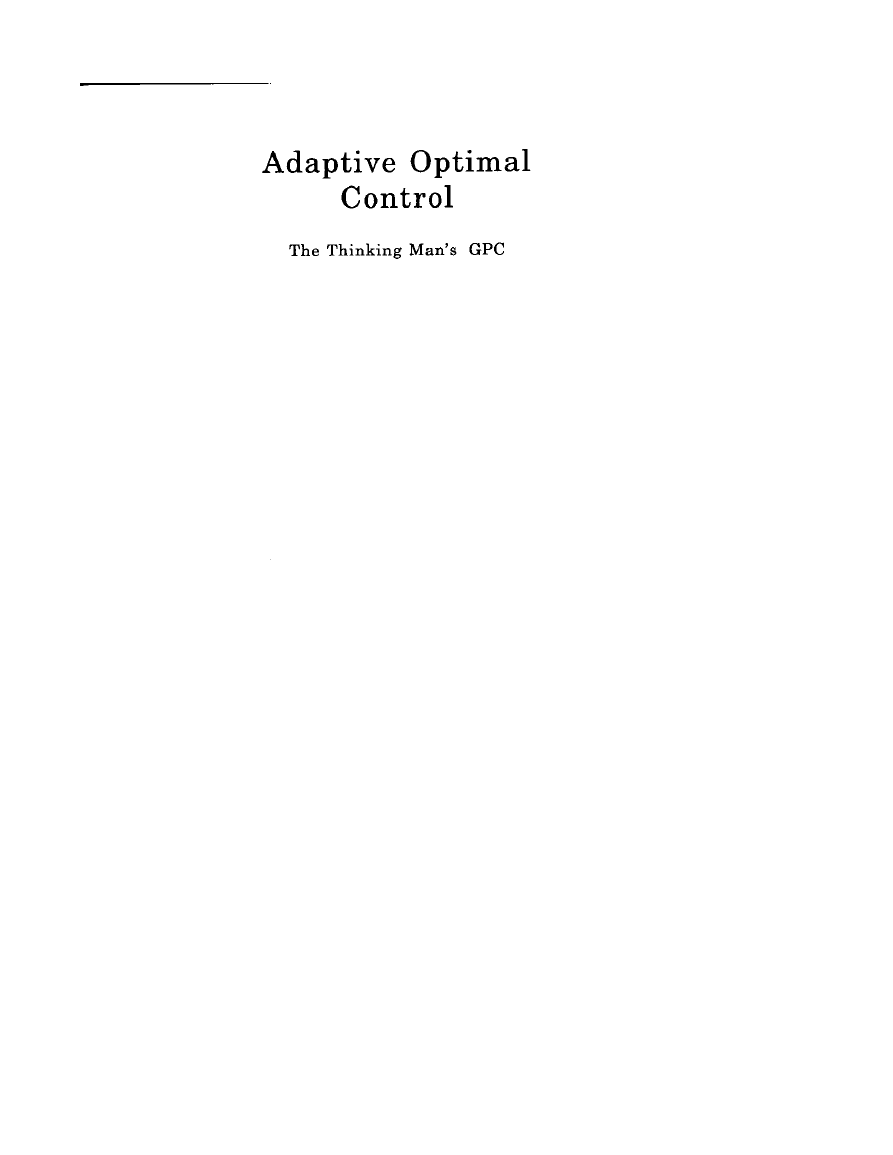
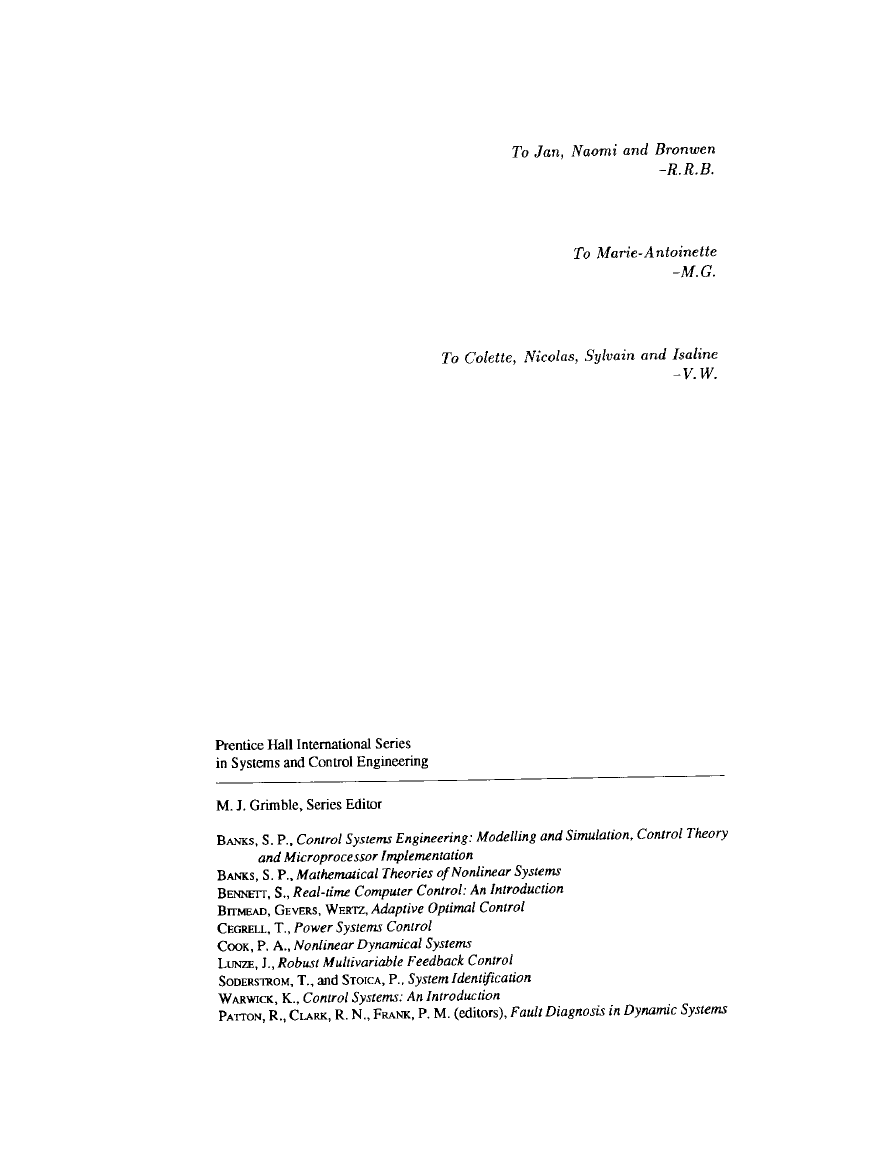
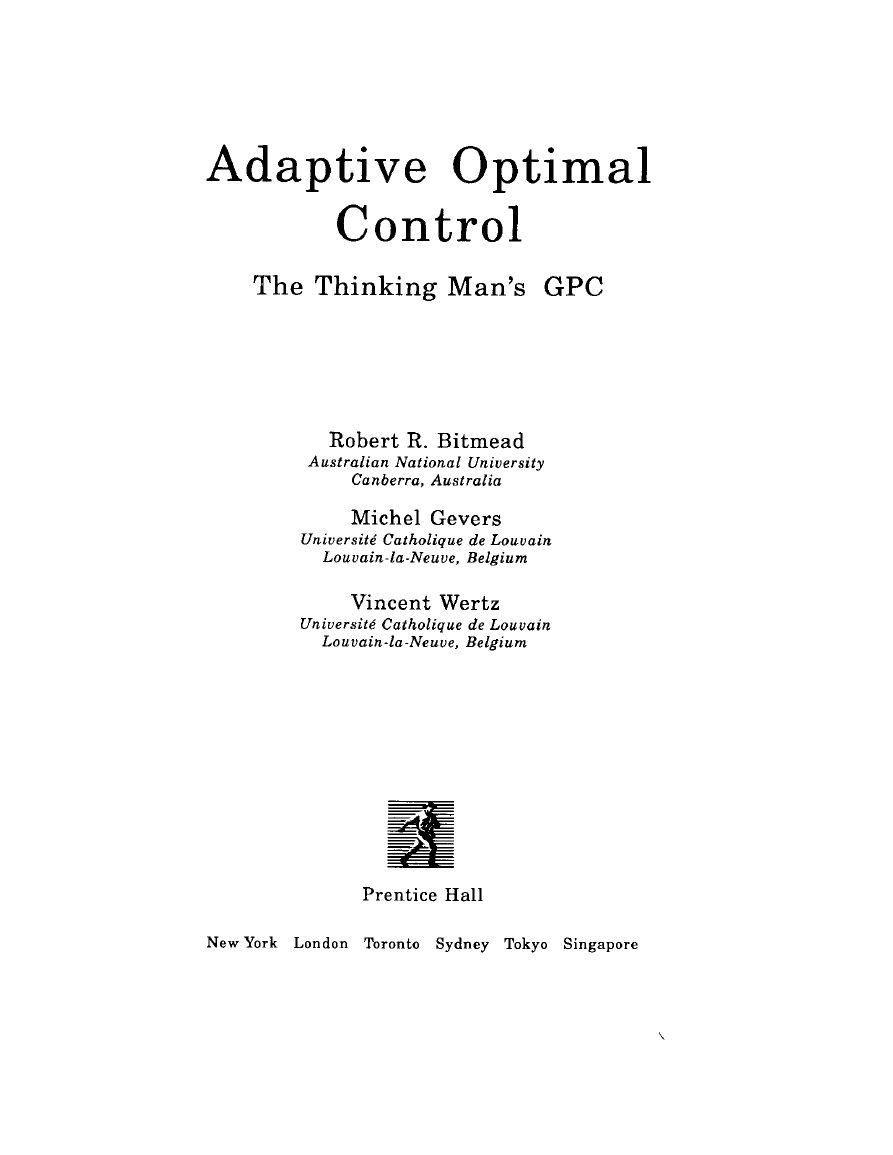

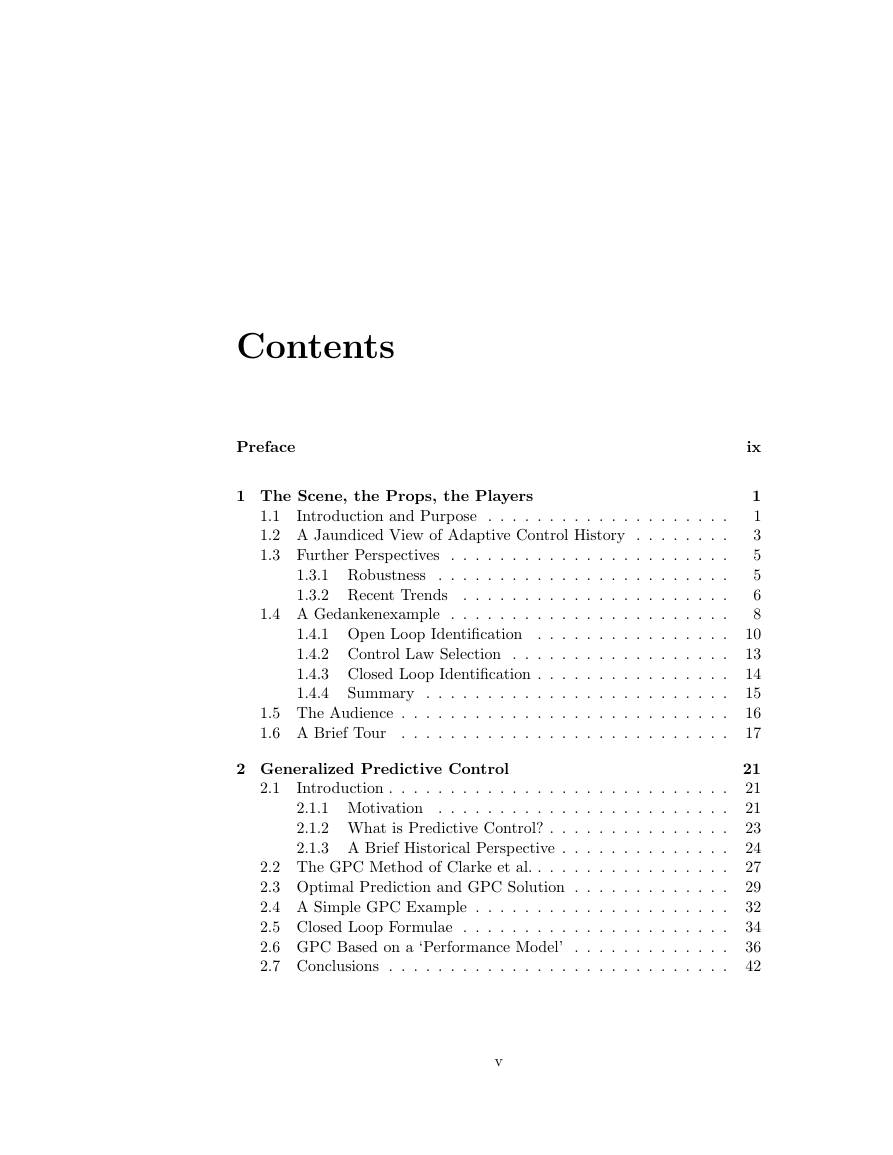

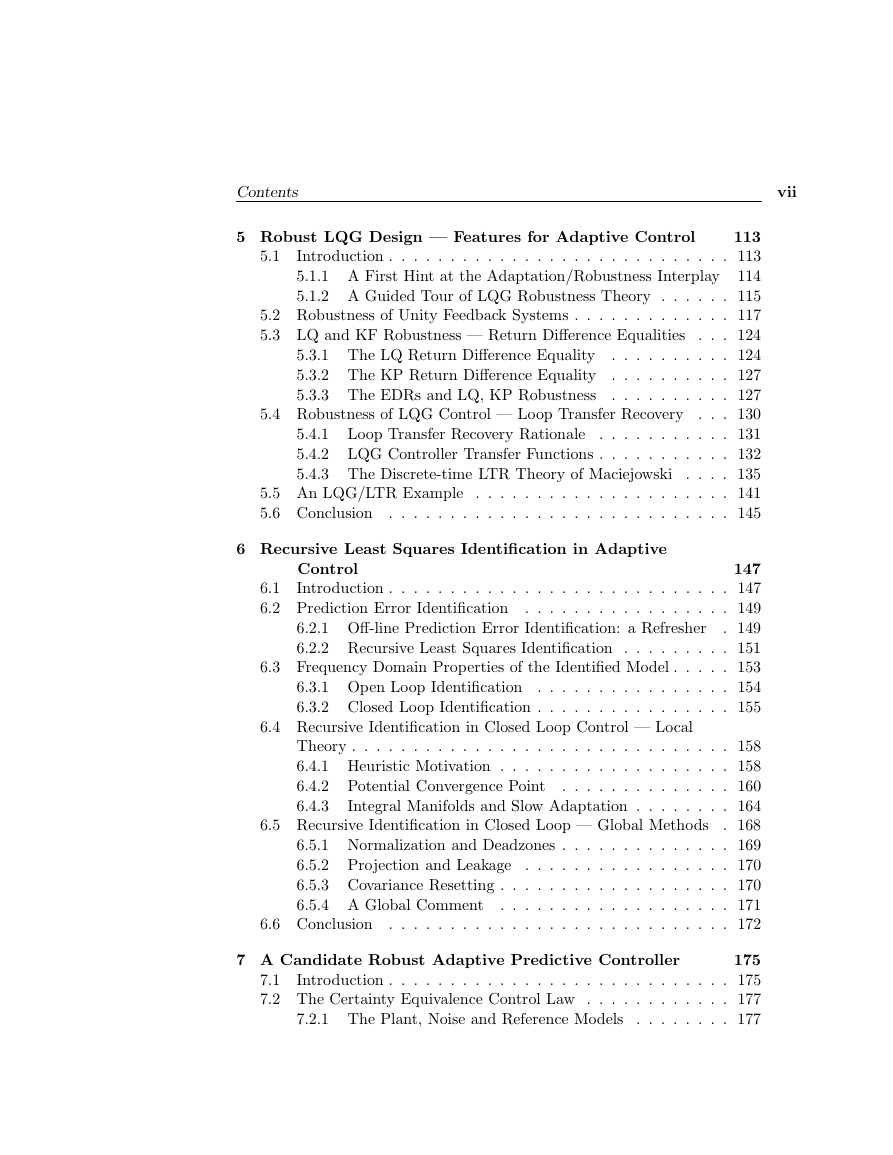









 2023年江西萍乡中考道德与法治真题及答案.doc
2023年江西萍乡中考道德与法治真题及答案.doc 2012年重庆南川中考生物真题及答案.doc
2012年重庆南川中考生物真题及答案.doc 2013年江西师范大学地理学综合及文艺理论基础考研真题.doc
2013年江西师范大学地理学综合及文艺理论基础考研真题.doc 2020年四川甘孜小升初语文真题及答案I卷.doc
2020年四川甘孜小升初语文真题及答案I卷.doc 2020年注册岩土工程师专业基础考试真题及答案.doc
2020年注册岩土工程师专业基础考试真题及答案.doc 2023-2024学年福建省厦门市九年级上学期数学月考试题及答案.doc
2023-2024学年福建省厦门市九年级上学期数学月考试题及答案.doc 2021-2022学年辽宁省沈阳市大东区九年级上学期语文期末试题及答案.doc
2021-2022学年辽宁省沈阳市大东区九年级上学期语文期末试题及答案.doc 2022-2023学年北京东城区初三第一学期物理期末试卷及答案.doc
2022-2023学年北京东城区初三第一学期物理期末试卷及答案.doc 2018上半年江西教师资格初中地理学科知识与教学能力真题及答案.doc
2018上半年江西教师资格初中地理学科知识与教学能力真题及答案.doc 2012年河北国家公务员申论考试真题及答案-省级.doc
2012年河北国家公务员申论考试真题及答案-省级.doc 2020-2021学年江苏省扬州市江都区邵樊片九年级上学期数学第一次质量检测试题及答案.doc
2020-2021学年江苏省扬州市江都区邵樊片九年级上学期数学第一次质量检测试题及答案.doc 2022下半年黑龙江教师资格证中学综合素质真题及答案.doc
2022下半年黑龙江教师资格证中学综合素质真题及答案.doc